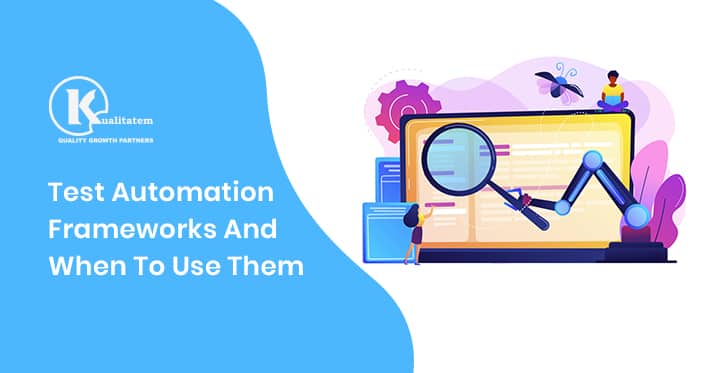Test Automation Frameworks And When To Use Them

- June 22, 2020
- HibaSulaiman
Testing frameworks are the key to the success of an automation testing process. QA teams looking forward to optimizing their testing processes should choose the right framework as it provides a higher return on investment (ROI). An automation testing company allows QA teams to manage test data better and utilize results to ensure software quality. There are countless benefits of test automation including maximum test coverage, automating repetitive testing tasks, etc. Test automation is the process of running tests automatically by using automation tools. It is used to control test execution so that the actual results can be compared with the expected results. By managing the repetitive tasks, including user interface testing and data flow between systems, automation allows manual testers to focus on the other aspects of software testing for quality assurance purposes.
Test automation has gained popularity in various industries and the early adoption of automated tests allow businesses to keep pace with the evolution of technology in the software testing industry. Since QA teams have limited time and resources to meet faster releases, test automation allows them to improve their test coverage. It focuses on repetitive test cases, whereas QA experts can manage their time in performing regression and exploratory testing.
Testing Frameworks
Before moving on to the different types of testing frameworks, it is important to learn what a test automation framework is. A testing framework is a set of guidelines to create and design test cases. It consists of various testing practices and tools that help QA teams in their testing efforts. These guidelines also include coding standards, handling test-data, how to access external resources, etc. It is not mandatory for QA testers to follow these guidelines, yet they could help testers in organizing their testing processes better, without missing any essential component.
Why Should QA Teams Use Test Automation Frameworks?
The primary reason for QA teams to use a test automation framework is to improve their speed and efficiency, cost reduction, etc. in software testing. Automating testing processes allow teams to:
- Reuse code
- Maximum test coverage
- Low-cost maintenance
- Minimum manual testing
- Easy reporting
Types of Test Automation Frameworks
There are 6 different test automation frameworks (as mentioned below), and each comes with its own advantages. Before making a test plan, it is important that QA teams select the right automated testing framework.
- Linear automation framework
- Data-driven framework
- Modular based testing framework
- Library architecture testing framework
- Keyword-driven framework
- Hybrid testing framework
Linear Automation Framework
A linear automation framework is also known as the record and play-back framework is a basic level testing framework. In this framework, testers create tests and write test scripts in sequential order. QA testers often use this framework for small applications.
A major reason why a team should choose a linear automation framework is that it is one of the fastest ways to generate test scripts. Testers do not need to write custom code, and the workflow is easier for any stakeholder to understand.
Data-Driven Automation Framework
In a data-driven framework, the test scripts’ logic is separated from the test data. Too often, testers may have to test the same feature or function of an app with different data sets. In such cases, test data should not be hard-coded into the script which is a great advantage of a data-driven automation framework. However, this is a time-consuming process as testers have to store the data, and pass the parameters from test scripts to the data source. Testers connect the data source directly to the script, which reads the relevant data. A table lists down each function of the data, with all instructions regarding how the test must be run.
QA teams may use this framework when they are required to reuse data sets multiple times. As the data is not hard-coded, testers can make changes to the script as required.
Modular Based Testing Framework
In this framework, testers are required to divide an application into different units that will be tested separately. Once an application is divided into individual modules, testers create a test script for each part and then combine to build larger tests to represent different test cases.
This framework requires less effort, as with slight variations in the test scripts testers can reuse them in different modules. So if a change in a certain module is made, they do not have to test the entire application again, thus a time-saving solution.
Library Architecture Testing Framework
Similar to a modular framework, a library architecture framework has some additional benefits. It does not break an application into various scripts, instead, it identifies similar tasks in the scripts and groups them according to function. All these functions are placed in a library and testers can use these test scripts whenever required.
When teams need higher reusability of test scripts, they use this framework to test an application with common functions that can be used by multiple test scripts.
Keyword-Driven Framework
In this framework, each function of an application being tested is laid out in a table with instructions for each test that needs to be run. It is similar to the data-driven framework, but this framework follows another approach that makes it different. Keywords are stored in a table, and they become a part of the script that represents various actions performed to test the graphical user interface (GUI) of an application. QA teams use this approach to save time, as they can reuse a single keyword across multiple test scripts.
Hybrid Testing Framework
As the name suggests, QA teams can use different parts of any testing framework to achieve most of the test automation efforts. As each framework has its own limitations, to meet the current customer demands for faster and quality app release, teams use a combination of different testing approaches.
Choosing an automation testing framework can be overwhelming for teams. Since each software testing project is unique, one size may not fit for all. Likewise, the same framework may not be useful for all software testing processes. So teams working for an automation testing company may either use from a list of the above-mentioned frameworks or simply use a hybrid testing strategy.











